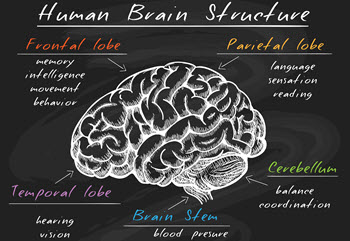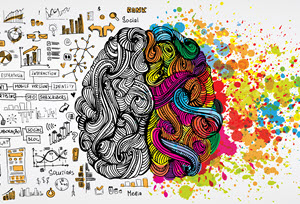In therapy, it is common to hear that our past has an impact on our current behaviors.
But how is that so?
 Our brain stores our memories in what is described as networks. To explain this, it helps to imagine a timeline that starts with a childhood event. You experience this event and after processing (whether a good or poor understanding of the even) you develop a belief about yourself.
Our brain stores our memories in what is described as networks. To explain this, it helps to imagine a timeline that starts with a childhood event. You experience this event and after processing (whether a good or poor understanding of the even) you develop a belief about yourself.
For the sake of this post, we will suggest a negative thought was developed (“I am unlovable”) thus creating a memory network. As you progress through life you will behave in a manner that builds off this negative thought that “I am unlovable”, creating additional memories on this network. Each memory supports the negative thought, “I am unlovable”. For the sake of clarity, we will use “I am unlovable” as the negative thought for the duration of this post.
When you experience an event you would have developed a belief about yourself. This is known as either a negative cognition or positive cognition
When we experience a recent event it will connect to a similar memory we previously experienced (strengthening the network and associated negative thought “I am unlovable”), and you will feel the same emotions from that previous memory in the current event. This is why it will feel like you are stuck in the past. Each memory influences your emotions and choices during that time (once again, strengthening the thought “I am unlovable” on your network).
It is very common that you may have a recent event, feel the discomfort, and not know where this feeling is coming from. This is because your initial memory may be buried deep in your psyche, or there are so many memories you can’t identify which one is the initial memory. In order to change your current emotions, you must change your perspective from the initial memory that created the “I am unlovable” network. This will reduce the intensity of the distressing emotion in this memory and all of your other memories linked to this network, including your most recent memory.
REMEMBER: YOU CANNOT CHANGE THE PAST. WHAT HAS HAPPENED CANNOT BE UNDONE, AND IT IS NOT HELPFUL TO FORGET THE PAST. YOU ARE CHANGING YOUR BELIEF ABOUT THAT EVENT AND BY DOING SO YOU WILL REDUCE THE INTENSITY OF THE SYMPTOMS YOU ARE CURRENTLY FEELING.
A Snapshot: Neurobiology of How We Are Impacted By Our Memories
Our brain is made of multiple parts. There is a higher functioning part (that controls logic, rational thoughts, language, and perceptions). There is a lower functioning part (that controls impulse, emotions, and memories), and there is the brain stem (that controls automatic behaviors such as heart rate, breathing, digestion, eye blinking…etc.). To understand where each part are located in our brain, the higher functioning part is located on the top part of our brain, while the lower functioning is located under the brain on top of the brain stem. The brain stem is connected to our spine and nervous system.
 There is a higher functioning part (that controls logic, rational thoughts, language, and perceptions). There is a lower functioning part (that controls impulse, emotions, and memories), and there is the brain stem (that controls automatic behaviors such as heart rate, breathing, digestion, eye blinking…etc.).
There is a higher functioning part (that controls logic, rational thoughts, language, and perceptions). There is a lower functioning part (that controls impulse, emotions, and memories), and there is the brain stem (that controls automatic behaviors such as heart rate, breathing, digestion, eye blinking…etc.).
Within the lower functioning part of our brain (we will call the limbic system) there is a part called the hippocampus that plays an essential part in our memories. There is also another part called the amygdala that serves like an alarm to our brain. How this function is that we live life and we have experiences. Our brain begins to process the experience.
The hippocampus is responsible for storing the memory and the higher functioning part of our brain will begin to process it. Our brain will store what we learn from it and discard what we don’t learn from the experience. This would be how we store the initial memory.
Understanding our limbic system is essential in understanding why we think and behave the way we do
As we continue to live life we will begin to continue to experience events and the hippocampus will begin to store these memories throughout our brain in networks. Our amygdala will continue to scan our surroundings for any type of danger, or frightening situation. If it senses danger it will alert the hippocampus to retrieve a memory to learn how we overcame similar situations (this initiates the linking between a current event and an initial memory on the network). If our brain tells us we are in danger or unsafe it will trigger the brainstem to respond in the same manner as it did during the initial memory.
What this would look like is, you will begin thinking the same thoughts as you did during the initial memory, and begin feeling the same emotions you did but this time in the present. So if you experienced an event and you attached a thought to that memory that made you feel sad. Your brain will remember that you came over that event by feeling numb and sadness (and whatever behavior you did during that time). So when you mentioned that you feel like an adolescent when you are with your parents, it is because when you are with your parents (long story short) your brain connected your current situation to a past experience (initial) and you begin thinking, feeling, and behaving as if you were living in that initial memory. As a result your body (heart rate, breathing… etc) will continue to behave as you once did.
What if I don’t remember the initial memory, can I still change the memory network?
But, I don’t remember my initial memory. Can this still work for me?
 Yes, you can. Because all of the memories are linked to the same network, changing one of the memories will alter the entire network. Another interesting phenomenon is that people are reporting that accessing one memory activates the link to a deeper memory that they had never previously recalled. So start with what you remember and go from there.
Yes, you can. Because all of the memories are linked to the same network, changing one of the memories will alter the entire network. Another interesting phenomenon is that people are reporting that accessing one memory activates the link to a deeper memory that they had never previously recalled. So start with what you remember and go from there.
This feels like I’m lying to myself, Am I lying to myself?
No, you are not lying to yourself. What you are doing is rephrasing what you understood into a thought that brings less discomfort.
When we look at the famous “glass half-empty” analogy, we can choose to either perceive the glass as “half-empty” or “half-full” neither perspective is a lie but each perspective will elicit a different emotion within us (e.g. half-empty may give a sense of dismay or sadness while half-full may give a sense of hope or joy). This is what we are doing with your memories.
It’s Time to Take Back Control of Your Emotions and Behaviors
 Now that you have begun to understand a little of the secret behind your current emotions and behaviors. Now what?
Now that you have begun to understand a little of the secret behind your current emotions and behaviors. Now what?
Take back control of your emotions and behaviors by practicing mindfulness, meditation, and positive thinking.
The most effective approach is first learning how to manage the physiological effects of the emotion that you are currently feeling (this is the discomfort you currently feel), before altering the thought.
The best approach to managing the physiological effects is with mindfulness techniques. This will allow you to not only control your discomfort but also give you a tool to protect yourself when you do visit any memory and began to feel triggered.
Once you are able to control the physiological effects of your emotions, you can began changing your perspective into ones that brings you less discomfort.



